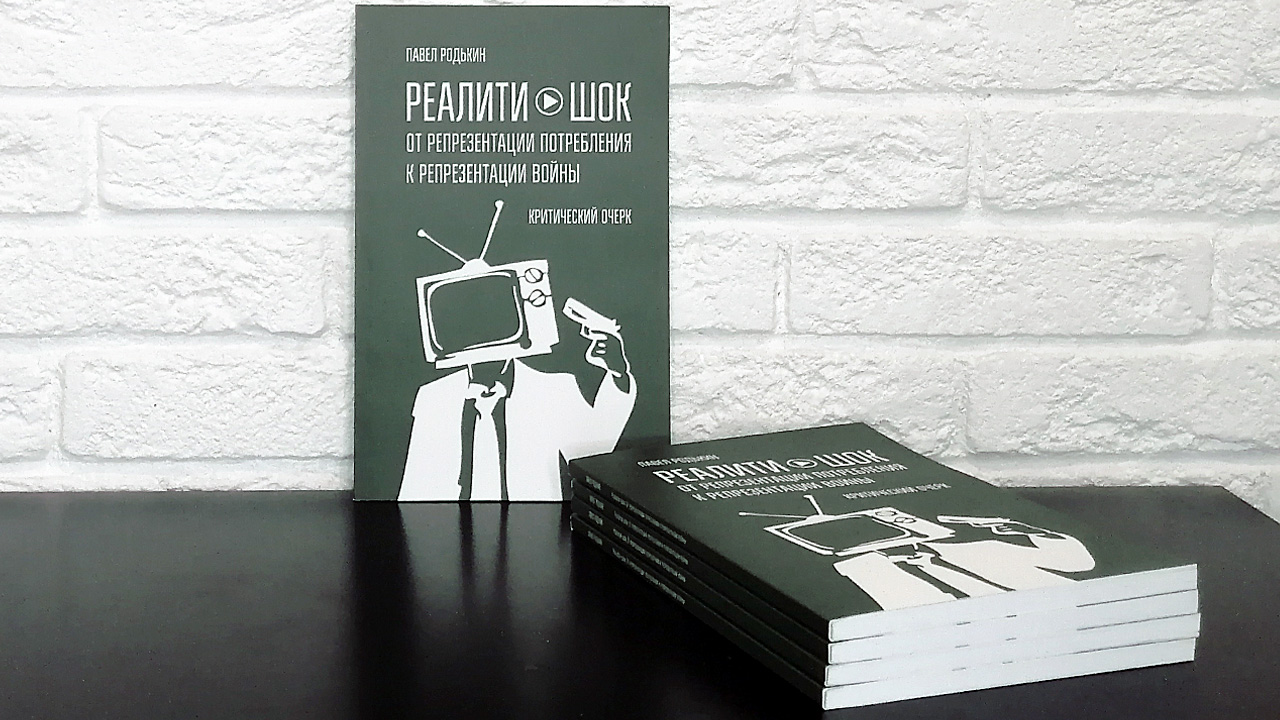

Rodkin, P. (2016). Reality Shock. From the Representation of Consumption to the Representation of War: Critical Essay. Moscow: Sovpadenie. 112 p. (In Russ.). [Rod'kin, P. (2016). Realiti-shok. Ot reprezentacii potrebleniya k reprezentacii vojny: Kriticheskij ocherk. Moskva: Sovpadenie.].
In the XXI century, the war turns into a reality show, involving the broad masses in virtual reality is replaced by simulacrum and is endowed with properties that can be controlled in real-time. The author carried out extensive work on the study of the representation of "war" in the transition from the globalisation of consumption the globalisation of war and the development of the network of the panoptic technology. The book is of interest to political scientists, sociologists, culturologists, as well as anyone interested in global communication processes in modern society.
Language: Russian
Design: Pavel Rodkin
Paperback: 112 pages
Size: 130x200 mm.
ISBN 9785903060993
The cover features graffiti elements by Keizer (keizerstreetart.wix.com)
© Rodkin, P., 2016
© Publishing house "Sovpadenie", 2016
Redactor's Foreword
Panoptism as a social need
New Panopticon: from TV to Internet
Media cannibalism: from peace to war
Instead of a conclusion: the collapse of digital humanism
Bibliography
Supplement: Video content from Syria in the news reports of Russian online media

The relevance of the topic is due to the complex processes of the dialectic of war and communications, the study of which allows one to reveal the "sleeping" archetypes of the mass unconscious in peacetime, to discover in them the germs of a future war. Based on extensive historical material, as well as in the context of the theoretical works of Western and Russian thinkers, the author shows the socio-cultural context of the traumatic reality of the 20th century, in which technology has brought the "face of war" to every home.
Lubov Choi
The young, but already acclaimed, Russian researcher Pavel Rodkin has written a timely book. He has taken on an almost impossible topic! The representation of war under conditions of stalled globalization and integrated communications is a topic as fundamental as it is mosaic, manifesting itself from different angles, depending on the angle of the author.
The problem is that to the initial mosaic is now added political urgency, when the next "face of war" and the methods of its representation to society are taking shape before our eyes and it is so easy to slip unnoticed into a discussion of technology instead of an analysis of the fundamental roots of the phenomenon. In this respect, Pavel Rodkin's book compares favorably with most attempts to study the problem, although we realize, of course, that this is still only the first step toward understanding the phenomenon.
It is important that all these "different faces" of war were not even in the twentieth century, when the means of communication and, above all, the visualization of events became available to a mass audience. Genuine "images of war" were the domain of the elite classes. A large part of the population perceived "the war" as a tragedy, but, if I may say so, "in retelling" it, and repeatedly. A mass, generally accessible representation of the war could be considered "heroic" staged photographs of men in uniform, which filled family photo albums in abundance. Here too, the stability of political and social systems was secured. Society was, to a certain extent, emancipated from the image of war itself, as long as war did not come into their house. But the principle of war representation, which Pavel Rodkin writes about, had already begun to take shape with regard to the social and technological conditions that existed.
Ultimately, the "representation of war" implies two sides: those who represent "war", or rather the image that in this particular society is considered war, and the side that, as Pavel Rodkin correctly noted, "consumes" this image. The problem with the contemporary representation of war is not only that it has been presented to global society. The problem is that the people involved in the informational and social processes of globalization, tens and hundreds of millions of people, have consumed this representation and become accustomed to the fact that "war on Facebook" is the main, if not the only, image of war that they may encounter during their quiet life as European or American consumers.
And in this sense, the work of Pavel Rodkin is important because it gives us a new methodological paradigm for discussing the study of the problems of the development of information society (and, alas, of information manipulation) in the modern era. A paradigm that will be much more reliefful and multilayered than the now commonplace discourse about technology as the sole driver of military development. The work of Pavel Rodkin shows us the complex dialectics of social demand, if you will, the multiplicity of drivers for the development of military power in today's world, among which the factor of a consumerist representation of war was and probably still is not the last one.
A new "face of war" is already beginning to appear through the fog of virtual reality, but so far we can only guess what it will be. This means that many surprising discoveries await us, and that the author will be faced with an equally large volume of new, profound and large-scale research.
Dmitry Evstafiev